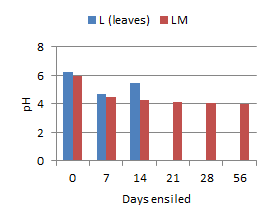 |
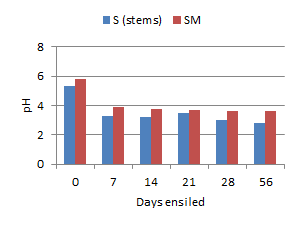 |
| Figure 1. Changes in pH of Taro leaves ensiled with or without molasses (M) | Figure 2. Changes in pH of Taro stems ensiled with or without molasses (M) |
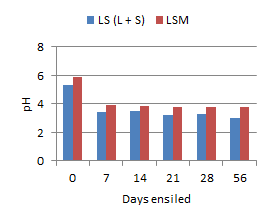 |
|
|
Figure 3. Changes in pH of Taro leaves +
stems ensiled |
|
|
Live stock production, climate change and resource depletion |
In the first of two experiments, Taro leaves and stems (Colocacia esculenta) were ensiled separately or together with or without the addition of 4% molasses. The Taro plants were purchased from farmers, who cultivated them in their fields or gardens. The foliages (leaves and stems) were harvested by taking the mature leaves (+ stems) from the taro plant, after that cleaning and chopping finely (1 - 2 cm length) and sun drying for one day to reduce the moisture to about 65 - 70%. After that the chopped foliage was ensiled with or without addition of molasses.. Ensiling was done in sealed plastic bags. There were 6 bags per treatment which enabled one bag per treatment to be sampled at 6 intervals from before, to 56 days after, ensiling.
There were major differences in the pH of the ensiled Taro according to the part of the plant (leaves or stems) and addition of molasses. The leaves needed addition of molasses for satisfactory silage whereas molasses was not necessary for ensiling of stems, or the combined leaves plus stems, the pH of which fell to 3.5 within 7 days of ensiling.
In Experiment 2, 10 Mong Cai sows were allocated to 2 dietary treatments: ensiled Taro leaves and stems replacing 50% of the protein supplied by soybean meal (ELS50) or 100% (ELS100). The leaves and stems were ensiled without molasses. The rest of the feed was rice bran, cassava root meal, broken rice and for the diet ELS50, soybean meal. The crude protein content was 13% in DM. During pregnancy the mixed feed was fed at 1.5 kg (DM) per day while in lactation it was ad libitum.
Litter weight and size at birth were not affected by the level of inclusion of Taro silage in the diet. At 21 days, litters from sows fed 100% replacement of soybean by Taro silage were some 15% lighter; however, at weaning the difference had reduced to about 12%. Litter size at weaning was the same for both treatments. There were no differences in live weight at farrowing of sows fed the diets with 50 or 100% replacement of soybean meal by Taro silage, but weight loss during lactation was 2kg more with the 100% Taro silage replacement. The interval from weaning to first estrus was increased from 8 to 12 days when the Taro silage level was increased. It was calculated that the net feed cost for one reproductive cycle could be reduced from 1.6 to 0.66 million VND (81 to 33 USD) assuming the Taro was grown and the silage made with family labour.
In the coastal region of Thua Thien Hue province (Phu vang, Phong Dien, Huong Thuy districts), there is a large area of sandy soil (about 150,000 ha), where farmers traditionally cultivate several species of taro; Bac Ha (Alocasia odora), Quang (Xanthosoma violeaceum) and Cham (Colocasia esculenta). The roots are used mainly for human consumption while the leaves and stems are boiled and fed to pigs. .
In Vietnam there are about one million Mong Cai (MC) sows, concentrated in the North and Central region of Vietnam (Hoang Nghia Duyet 1992). The traditional way of feeding MC sows in Central Vietnam is to use a large proportion of vegetables in the diet such as sweet potato leaves, taro leaves and water spinach, mixing them with rice bran, cassava root meal, broken rice and then cooking the mixed feed before offering it to the pigs.
Recently (http://www.mekarn.org/proprf/content.htm), increasing attention has been given to improving the utilization of vegetative plants as a replacement for soybean and fish meal in pig diets, in view of the increasing cost of these conventional protein sources. Sweet potato leaves were studied by Hoang Nghia Duyet et al (2003) and shown to be a suitable replacement for up to 50% of the soybean meal in diets of Yorkshire and Mong Cai sows. At higher levels (100% replacement) the reproductive performance of the Yorkshire sows was markedly compromised; by contrast, the Mong Cai sows were found to be less affected by the high forage levels. More recent research has focused attention on the foliage of the plants of the Colocacia family (Colocacia, Alocacia and Xanthosoma spp) which appear to offer most potential as protein sources for pigs (Pham Sy Tiep et al 2006; Rodríguez et al 2009a,b; Du Thanh Hang and Preston 2009, 2010; Chhay Ty et al 2010). However, these studies have been mainly with growing pigs and so far there is only limited research on feeding of taro foliage to pigs during pregnancy and lactation (Chittavong Malavanh et al 2008; Sivilai et al 2010).
The objective of this study was to evaluate (i) different way of ensiling Taro foliage (leaves and stems); and (ii) the use of the ensiled Taro foliage to replace soybean meal in the diets of Mong Cai sows.
The 6 treatments in a completely randomized design were:
L: no addditive
LM: Leaves + molasses at 4% (fresh basis)
LS: Leaves + Stems (no additive)
LSM: Leaves + Stems + molasses at 4% (fresh basis).
S: Stems no additives
SM: Stems + 4% molasses
pH, DM and crude protein contents of the silages were determined on samples taken before and 7, 14, 21, 28 and 56 days of the ensiling process. pH was determined with a digital pH meter on the expressed juice. DM and crude protein were determined according to AOAC (1990) procedures.
Ten Mong Cai sows were allocated to 2 dietary treatments
ELS50: Ensiled Taro leaves and stems replacing 50% of the protein supplied by soybean meal
ELS100: Ensiled Taro leaves and stems replacing 100% of the protein supplied by soybean meal
The silage was made from combined leaves + stems, without molasses, following the procedure described in Experiment 1. After 28 days, the ensiled taro foliage was fed to the pigs. Feeding was 2 times per day (at 10.00 and 17.00 h for pregnancy) and 3 times/ day (at 7.00, 12.00 and 17.00 h for lactation period).
The 10 Mong cai sows were located on farms in Vinh Phu commune (Phu Vang distict, Thua Thien Hue province). All of them were from third parity with a live weight of about 80 kg. They were allocated at random to the two diets. All sows were mated by AI with the same semen of Yorkshire boar. The sows were kept in individual concrete floor pens. Three weeks after mating, the sows were fed the experimental diets (Table 1). For the pregnancy period, the sow was fed 1.5 kg of feed/ day (in DM). In lactation, the sow was fed with increasing amounts after farrowing and after 5 days feeding was ad-libitum. Crude protein levels were 13% in DM in the diets for pregnancy and lactation period.
| Table 1. The composition of the diets | |||||
|
|
DM |
CP |
Price (VND/kg) |
ELS 50 |
ELS 100 |
|
Ensiled taro leaves+stens |
196 |
178 |
2551 |
0.20 |
0.52 |
|
Rice bran |
887 |
116 |
3382 |
0.18 |
0.18 |
|
Cassava root meal |
900 |
34 |
2889 |
0.37 |
0.20 |
|
Broken rice |
873 |
96 |
6873 |
0.15 |
0.10 |
|
Soybean meal |
890 |
460 |
16854 |
0.10 |
0 |
|
Total DM (kg) |
|
|
|
1.00 |
1.00 |
|
CP (g/ kg DM) |
|
|
|
130 |
130 |
|
Price (VND/ kg DM) |
|
|
|
4904 |
3200 |
|
Weight of fresh feed (kg) |
|
|
1.92 |
3.19 |
|
Records were kept of:
Feed intake
Live weight at the beginning and end of pregnancy and end of lactation.
Litter size at birth and at weaning (45 days).
Live weight of the piglets at birth and at weaning
Litter weight of piglets at 21 days of age (potential of sow lactation)
Feed conversion (amount and cost to produce 1 kg of weaned piglet).
There were major differences in the pH changes of ensiled Taro according to the part of the plant (leaves or stems) and addition of molasses (Table 2; Figures 1 to 3). The leaves needed addition of molasses for satisfactory silage whereas molasses was not necessary for ensiling of stems, or the combined leaves plus stems. These results are similar to those reported by Rodriguez and Preston (2009).
|
Table 2. pH changes in the ensiling of Taro leaves, stems or leaves + stems, with or without molasses, over 56 days |
||||||
|
Days |
0 |
7 |
14 |
21 |
28 |
56 |
|
LM |
5.99 |
4.50 |
4.30 |
4.11 |
4.05 |
3.99 |
|
SM |
5.78 |
3.89 |
3.79 |
3.72 |
3.62 |
3.62 |
|
LSM |
5.90 |
3.91 |
3.86 |
3.78 |
3.76 |
3.75 |
|
L (leaves) |
6.23 |
4.70 |
5.50 |
|
|
|
|
S (stems) |
5.35 |
3.31 |
3.25 |
3.51 |
2.99 |
2.8 |
|
LS (L + S) |
5.34 |
3.45 |
3.53 |
3.24 |
3.28 |
3.0 |
 |
 |
| Figure 1. Changes in pH of Taro leaves ensiled with or without molasses (M) | Figure 2. Changes in pH of Taro stems ensiled with or without molasses (M) |
 |
|
|
Figure 3. Changes in pH of Taro leaves +
stems ensiled |
|
As expected there were no changes in the percentages of DM and crude protein after ensiling the different Taro fractions for 21 days (Table 3). The DM and crude protein contents were some three times higher in leaves than in stems.
|
Table 3. Changes in DM and crude protein in the ensiling of taro leaves (L), stems (S) and leaves+stems (LS) , with or without molasses (M) |
||||
|
|
DM (%) |
CP (%) |
||
|
Days |
0 |
21 |
0 |
21 |
|
LM |
39.1 |
40.9 |
24.3 |
24.9 |
|
SM |
15.0 |
15.3 |
9.02 |
9.77 |
|
LSM |
20.4 |
19.6 |
17.3 |
17.8 |
|
L |
16.1 |
|
26.8 |
|
|
S |
9.49 |
8.49 |
7.62 |
7.92 |
|
LS |
12.7 |
12.5 |
18.0 |
18.5 |
Litter weight and litter size at birth were not affected by the level of inclusion of Taro silage in the diet (Table 4 and Figures 4 and 5). At 21 days, litters from sows fed 100% replacement of soybean by Taro silage were some 15% lighter; however, at weaning the difference had reduced to about 12%. Litter size at weaning was the same for both treatments (Figure 5)
|
Table 4. Mean values (± SE) for reproductive performance of MC sows fed diets with 50 or 100% of soybean meal replaced by Taro leaf and stem silage |
|||
|
|
ELS 50 |
ELS 100 |
P |
|
At birth |
|
|
|
|
Litter size |
12.60 ± 0.25 |
11.80 ± 0.58 |
0.24 |
|
Litter weight, kg |
8.82 ± 0.14 |
8.53 ± 0.43 |
0.49 |
|
Average weight, kg |
0.70 ± 0.006 |
0.72 ± 0.009 |
0.018 |
|
At 21 days |
|
|
|
|
Litter weight, kg |
31.00 ± 1.27 |
36.76 ± 1.88 |
0.035 |
|
At weaning |
|
|
|
|
Litter size |
11.00 ± 0.63 |
11.00 ± 0.45 |
1.0 |
|
Litter weight |
79.44 ± 2.24 |
89.50 ± 2.92 |
0.026 |
|
Average weight |
7.27 ± 0.17 |
8.15 ± 0.07 |
0.007 |
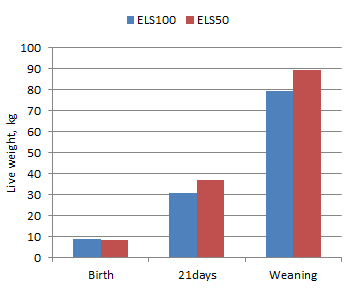 |
 |
| Figure 4. Effect on litter live weights of replacing 50 or 100% of dietary soybean mea, with Taro leaf and stem silage | Figure 5. Effect on litter size of replacing 50 or 100% of dietary soybean meal, with Taro leaf and stem silage |
There were no differences in live weight at farrowing of sows fed diet with 50 or 100% replacement of soybean meal by Taro silage (Table 5), but weight loss during lactation was greater with the 100% Taro silage replacement (Figure 6). The interval from weaning to first estrus was also increased when the Taro silage level was increased (Figure 7). The relatively small decreases in sow performance when the Taro silage completely replaced soybean meal are similar to those observed by Hoang Nghia Duyet et al (2010) when boiled leaves of Taro replaced soybean meal in diets of Mong Cai sows. Chittavong Malavanh et al (2008) and Sivilai et al (2010) also reported good reproductive rates in pure and crossbred Mong Cai gilts fed high levels of Taro leaf-stem silage in Lao PDR.
|
Table 5. Live weight loss during lactating time and re-mating of MC sows feeding ensiled taro leaves |
|||
|
|
ELS 100 |
ELS 50 |
P |
|
Live weight of sows, kg |
|
|
|
|
At farrowing |
106 ± 2.62 |
106 ± 2.98 |
0.92 |
|
At weaning |
89.6 ± 1.96 |
91.8 ± 2.52 |
0.51 |
|
Percentage loss in lactation |
18.7 ± 1.24 |
15.5 ± 0.42 |
0.036 |
|
Weaning to 1st estrus, days |
12.4 ± 1.17 |
8.0 ± 0.63 |
0.01 |
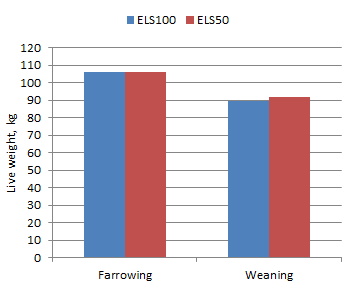 |
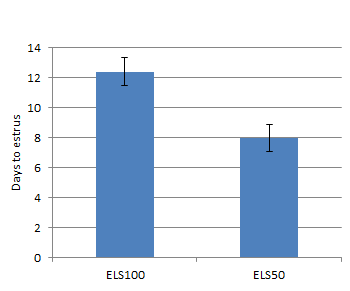 |
| Figure 6. Live weight at farrowing and weaning of sows fed diets with 50 or 100% replacement of soybean meal by Taro leaf and stem silage | Figure 7. Days from weaning to first estrus of sows fed diets with 50 or 100% replacement of soybean meal by Taro leaf and stem silage |
The benefit from feeding ensiled Taro foliage is considerable if it is assumed that growing the taro and making silage are tasks performed by family labour and therefore require no cash expenditure by the family. Thus assuming zero cost for the ensiled taro silage, the feed costs for one reproductive cycle (Table 6) are VND 1.624 million and 0.658 million (USD 81.2 and 32.9) for the ELS 50 and ELS 100 diets, ,respectively, representing a saving of VND 0.966 miilion (USD 48.30).
|
Table 6. Benefit from feeding ensiled Taro foliage to MC sows |
||
|
|
ELS 100 |
ELS 50 |
|
Feed DM per reproductive cycle, kg |
366 |
377 |
|
Feed DM to produce 1 kg piglet, kg |
4.60 |
4.22 |
|
Feed cost (excluding taro silage) (million VND) |
0.658 |
1.624 |
Taro stems, and stems + leaves, were ensiled satisfactorily without additives, the pH falling to 3.5 within 7 days. Leaves alone required addition of 4% molasses to make satisfactory silage.
Reproductive performance of Mong Cai sows was reduced only slightly, but with economic benefits, when the soybean meal in a diet based on rice bran, cassava root meal and broken rice, was replaced completely by Taro leaf-stem silage.
The author acknowledges the support for this research received from the MEKARN program, financed by Sida.
AOAC 1990
Official methods of analysis. Association of Official Analytical Chemists,
Arlington, Virginia, 15th edition, 1298 pp.
Chittavong Malavanh, Preston T R and Ogle B 2008 Effect of replacing soybean meal by a mixture of taro leaf silage and water spinach on reproduction and piglet performance in Mong Cai gilts. Livestock Research for Rural Development. Volume 20, supplement. http://www.lrrd.org/lrrd20/supplement/mala2.htm
Chhay
Ty, Khieu Borin and Preston T R 2010
Effect of Taro (Colocasia
esculenta) leaf + stem silage and mulberry leaf silage on digestibility and
N retention of growing pigs fed a basal diet of rice bran. Livestock Research
for Rural Development. Volume 22, Article #109.
http://www.lrrd.org/lrrd22/6/chha22109.htm
Hoang Nghia Duyet, 1992. The results of survey of the reproductive performance of Mong Cai sows kept in Central Vietnam. Proceeding of Scientific congress of Hue Agricultural University , 1992. Page 80
Hoang Nghia Duyet, Nguyen Dinh Son, Nguyen Van An and Truong Thi Thuan 2003 Effect of high dietary levels of sweet potato leaves on the reproductive performance of pure and crossbred Mong Cai sows; In: Proceedings of Final National Seminar-Workshop on Sustainable Livestock Production on Local Feed Resources (Editors: Reg Preston and Brian Ogle). HUAF-SAREC, Hue City, 25 – 28 March, 2003. Retrieved, from http://www.mekarn.org/sarec03/duyethue2.htm
Hoang Nghia Duyet 2010 Giant taro leaves (Alocasia macrorrhiza) for replacement of soybean meal in diets for Mong Cai sows in Central Vietnam. Livestock Research for Rural Development. Volume 22, Article #149. http://www.lrrd.org/lrrd22/8/duye22149.htm
Du Thanh Hang and Preston T R 2009 Taro (Colocacia esculenta) leaves as a protein source for growing pigs in Central Viet Nam. Livestock Research for Rural Development. Volume 21, Article #164. http://www.lrrd.org/lrrd21/10/hang21164.htm
Du Thanh Hang and Preston T R 2010 Effect of processing Taro leaves on oxalate concentrations and using the ensiled leaves as a protein source in pig diets in central Vietnam. Livestock Research for Rural Development. Volume 22, Article #68. http://www.lrrd.org/lrrd22/4/hang22068.htm
Pham Sy Tiep, Nguyen Van Luc, Trinh Quang Tuyen, Nguyen Manh Hung and Tran Van Tu 2006 Study on the use of Alocasia macrorrhiza (roots and leaves) in diets for crossbred growing pigs under mountainous village conditions in northern Vietnam. Workshop-seminar "Forages for Pigs and Rabbits" MEKARN-CelAgrid, Phnom Penh, Cambodia, 22-24 August, 2006. Article # 11. RetrievedJuly 8, 110, from http://www.mekarn.org/proprf/tiep.htm
Rodríguez Lylian, Preston T R and Peters K 2009a Studies on the nutritive value for pigs of New Cocoyam (Xanthosoma sagittifolium); digestibility and nitrogen balance with different levels of ensiled leaves in a basal diet of sugar cane juice. Livestock Research for Rural Development. Volume 21, Article #27. http://www.lrrd.org/lrrd21/2/rodr21027.htm
Rodríguez Lylian, Peniche Irina, Preston T R and Peters K 2009b Nutritive value for pigs of New Cocoyam (Xanthosoma sagittifolium); digestibility and nitrogen balance with different proportions of fresh leaves and soybean meal in a basal diet of sugar cane juice. Livestock Research for Rural Development. Volume 21, Article #16. http://www.lrrd.org/lrrd21/1/rodr21016.htm
Rodríguez L and Preston T R 2009 A note on ensiling the foliage of New
Cocoyam (Xanthosoma sagittifolium). Livestock Research for Rural Development.
Volume 21, Article #183.
http://www.lrrd.org/lrrd21/11/rodr21183.htm
Sivilai B, Chittavong M and Preston T R 2010
Reproduction and piglet performance in Mong Cai gilts fed a mixture of taro leaf
silage and water spinach. Livestock Research for Rural Development. Volume 22,
Article #79.
http://www.lrrd.org/lrrd22/4/boun22079.htm